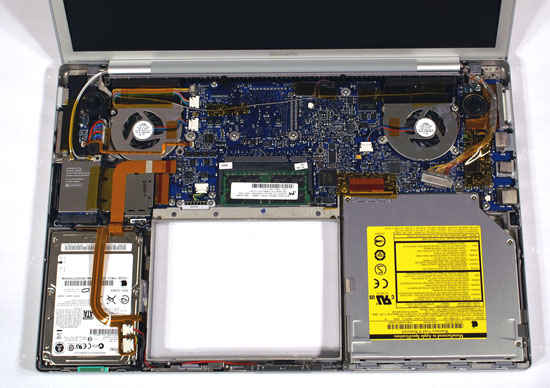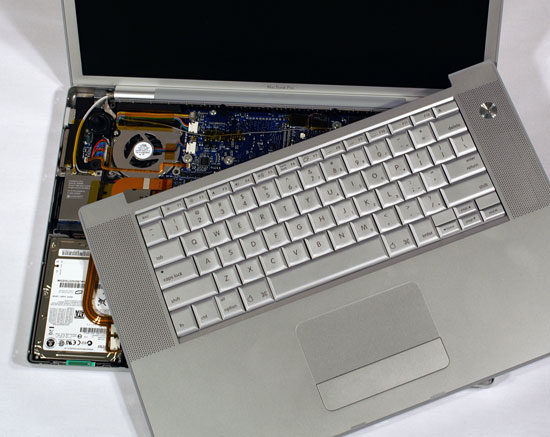Apple's MacBook Pro: Using it as a Mac and a PC
by Anand Lal Shimpi on April 13, 2006 12:00 AM EST- Posted in
- Mac
There are very few configurable options on the MacBook Pro, and the GPU is not one of them. The only GPU Apple offers is the ATI Mobility Radeon X1600; you do however have the ability to choose whether you want 128MB or 256MB of GDDR3 memory. The Mobility Radeon X1600 is a PCI Express GPU, which means that it has a high bandwidth data path to the 945 North Bridge and thus main memory. It sounds good for marketing, but with 128MB or 256MB of local memory the high bandwidth link with system memory isn't all that important.
The old 1280 x 854 panel from my 15" PowerBook G4 has been slightly upgraded to a 1440 x 900 panel. The vertical resolution hasn't been increased much at all but the increase in horizontal resolution is definitely noticeable and appreciated. Although the previous 15" was a good balance between portability and productivity, the 15" MacBook Pro improves on the balance even more thanks to its slightly higher resolution panel. I will say that the uniformity of the brightness of the panel doesn't seem to be as good as on my previous PowerBook; the panel does seem to get darker around the corners than the old panel. Obviously at different resolutions the two aren't necessarily comparable, but I wouldn't call the new panel a huge step forward. It's not bad by any means, but the brightness uniformity was one of the first things I noticed about it.
Just like its predecessor, the MacBook Pro features an integrated DVI output port, while also coming with a DVI-to-VGA dongle if you're connecting your notebook to a VGA display. An improvement over its predecessor is that its DVI output is dual link, meaning it can drive Apple's 30" Cinema Display and Dell's 3007WFP at their native resolution of 2560 x 1600.
The integrated 56K modem is finally gone from the old PowerBook's chassis, although Apple offers an optional USB modem if you absolutely need one.

The MacBook Pro's very tiny motherboard (Click to Enlarge)
For hard drives you can choose between 80GB and 120GB drives, all spinning at 5400RPM, with a single 100GB offering at 7200RPM as an option for added performance. At present, the largest laptop hard drives anywhere are only 160GB, so there's not much incentive to upgrade today. However, if you'd like to upgrade to a bigger hard drive down the road, it's not too difficult to do. Opening the MacBook Pro simply requires a small phillips head screwdriver and a T6 driver; remove all the screws along the outside and underneath the unit and you'll be able to lift out the keyboard.

Beneath the keyboard you'll see the hard drive, which after some careful disconnecting of cables can be removed.











52 Comments
View All Comments
Calin - Thursday, April 13, 2006 - link
This could be thanks to slower drivers in BootCamp Windows XP, or slower hard drive access/speed. Everything else is a disadvantage for VM: one more level of indirection in disk access, less memory, running the OS X behind the VM.Could you do some disk speed comparation between VM and native XP?
BigLan - Thursday, April 13, 2006 - link
I think it's going to be hard drive speed throwing off the benchmarks. The BootCamp partition is going to be at the outer edge of the disk, with much slower speeds than the VM client virtual drive which is on the faster Apple partition.I'm not sure if it's possible to assign the entire HD to a windows partition using Bootcamp, but that's about the only way i can think of to level the playing field.
Calin - Friday, April 14, 2006 - link
To nitpick, it would be at the center of the hard drive, not at the outer edge :) (ok, based on sector numbers, which starts at the edge).Near the "end" of the hard drive, the transfer speed is reduced (there are fewer bytes on a full circle).
jimmy43 - Thursday, April 13, 2006 - link
Excellent Review. This may be my first laptop purchase, seems to have everything I could possibly want.monsoon - Thursday, April 13, 2006 - link
Hello Anand,...i'm waiting for Parallels to finalize their VT release and maybe Merom Macs too...
I was wondering if the ONE CORE only VT tech is to be the final result of their virtualization software or just a middle-step.
Seems to me it's rather poor a solution ( ok, it's the best out there for now ) to use a dual-core computer to run both OS on a single core
=/
Better would be smart distribution of tasks to the CPU depending on which OS is actually under load...
...any thoughts / info on that ?
Thanks for your nice review !=)
plinden - Thursday, April 13, 2006 - link
Looking at CPU load while running Parallels VM, I see the load spread evenly over both processors (usually < 10% total CPU except at boot, when it reaches 150% CPU). It's just that the VM itself sees itself as running on a single processor.
shuttleboi - Thursday, April 13, 2006 - link
I've read that the ATI X1600 in the Mac can run games well, but only IF you overclock the GPU. I can't imagine the Mac getting any hotter than it already supposedly is, and the idea of overclocking an already hot laptop is not appealing.JoKeRr - Thursday, April 13, 2006 - link
Overall I enjoyed it.Would have been nice to see a comparison of screen brightness, as apple claimed 67% brighter!
And also, the slowness in windows, could it be related to chipset driver stuff?? And what's the gaming experience so far like?? Would it be similar to a desktop 6600 or 6600gt??
Thank you.
rolls - Friday, April 14, 2006 - link
Very interesting numbers all round.35% improvement in iTunes when comparing a single core 1.5GHz 7447 with the old slow bus etc, and a new 33% faster dual core intel CPU. 50% improvement in H.264 encoding etc. These numbers suggest that had Apple stuck with Freescale and moved to e600 core based systems, performance figures could have been off the scale. If only...
JarredWalton - Thursday, April 13, 2006 - link
On paper the X1600 Pro desktop cards actually look pretty decent. 12 pipelines at 500 MHz, with 800 MHz RAM. I would have thought they would at least give the 6600GT a run for the money, given how X1800 compares to 7800. Amazingly (to me), the X1600 gets completely stomped by the 6600GT. What's worse, the cards I have can't even overclock worth a darn on the memory side - 800 is stock, and they get unstable at even minor changes. (Could be an issue with the overclocking tool, though?)Anyway, for now I would say X1600 Mobility is going to be somewhere in the realm of 6600 (non-GT) performance, maybe slightly faster. That means gaming is definitely possible, but you will want low-to-medium detail levels for any recent titles. Just a guess, of course, and Anand will have to run benches to get any final confirmation. Really, though, this laptop isn't intended as anything more than a light gaming solution.